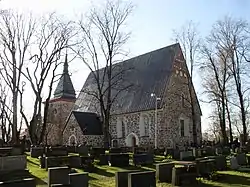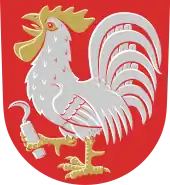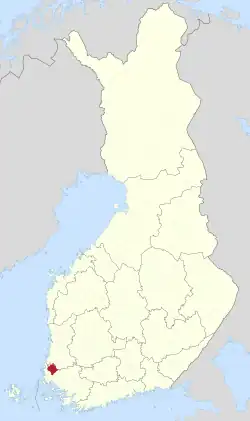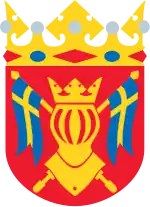Laitila
Letala | |
|---|---|
Town | |
| Laitilan kaupunki Letala stad | |
 Laitila Church | |
 Coat of arms | |
| Nickname: Egg Capital of Finland[1] | |
 Location of Laitila in Finland | |
| Coordinates: 60°53′N 021°42′E / 60.883°N 21.700°E | |
| Country | |
| Region | Southwest Finland |
| Sub-region | Vakka-Suomi sub-region |
| Charter | 1868 |
| City rights | 1986 |
| Government | |
| • Town manager | Johanna Luukkonen |
| Area (2018-01-01)[2] | |
| • Total | 545.32 km2 (210.55 sq mi) |
| • Land | 531.88 km2 (205.36 sq mi) |
| • Water | 13.65 km2 (5.27 sq mi) |
| • Rank | 164th largest in Finland |
| Population (2023-09-30)[3] | |
| • Total | 8,439 |
| • Rank | 116th largest in Finland |
| • Density | 15.87/km2 (41.1/sq mi) |
| Population by native language | |
| • Finnish | 89.9% (official) |
| • Swedish | 0.3% |
| • Others | 9.8% |
| Population by age | |
| • 0 to 14 | 16.2% |
| • 15 to 64 | 58.4% |
| • 65 or older | 25.3% |
| Time zone | UTC+02:00 (EET) |
| • Summer (DST) | UTC+03:00 (EEST) |
| Climate | Dfb |
| Website | www.laitila.fi |
Laitila (Finnish: [ˈlɑi̯tilɑ]; Swedish: Letala[6]) is a town and a municipality of Finland. It is located in the Southwest Finland region, and it is 59 kilometres (37 mi) from Laitila to Turku. The municipality has a population of 8,439 (30 September 2023)[3] and covers an area of 545.32 square kilometres (210.55 sq mi) of which 13.65 km2 (5.27 sq mi) is water.[2] The population density is 15.87 inhabitants per square kilometre (41.1/sq mi). The municipality is monolingually Finnish.
Laitila is renowned for its poultry farms and "egg festival" (Laitilan Munamarkkinat),[7] which is why the subject of the municipal coat of arms of Laitila also refers to the parish's fame for chicken care.[8] There is a lot of demand for Laitila-based chicken eggs, as the local egg producer company Munax, among other things, has even planned to egg exports all the way to South Korea.[9] Laitila has also been called the "egg capital of Finland".[1]
Culture
Laitila has a very large number of Iron Age antiquities, the most famous of which are the so-called the warrior's grave of Kodjala.[10] Finland's oldest glass object, the Roman-era drinking horn, has been found in Laitila's Soukainen village.[11] The nationally significant built cultural environments defined by the Finnish Heritage Agency in 2009 in Laitila include the Untamala[12] and Suontaka villages[13] and the Koukkela's the peasant house of Kauppila.[14]
People
- Kaarlo Heininen (1853–1926)
- Pasi Saarela (born 1973)
- Mika Kares (born 1978)
- Valle Mäkelä (born 1986)
- Markus Seikola (born 1992)
- Susanna Tapani (born 1993)
References
- 1 2 TS: Laitila on Suomen munapääkaupunki (in Finnish)
- 1 2 "Area of Finnish Municipalities 1.1.2018" (PDF). National Land Survey of Finland. Retrieved 30 January 2018.
- 1 2 "Preliminary population statistics 2023, September". StatFin. Statistics Finland. Retrieved 26 October 2023.
- ↑ "Demographic Structure by area as of 31 December 2022". Statistics Finland's PX-Web databases. Statistics Finland. Retrieved 6 September 2023.
- ↑ "Population according to age (1-year) and sex by area and the regional division of each statistical reference year, 2003–2020". StatFin. Statistics Finland. Retrieved 2 May 2021.
- ↑ Namn på kommuner från finska till svenska; Kotimaisten kielten keskus (in Swedish)
- ↑ Laitilan Munamarkkinat (in Finnish)
- ↑ Suomen kunnallisvaakunat (in Finnish). Suomen Kunnallisliitto. 1982. p. 139. ISBN 951-773-085-3.
- ↑ YLE: Laitilalainen munatuottaja Munax tähyää jo Etelä-Koreaan – vientiä suunniteltu jo vuosia (in Finnish)
- ↑ Paula Purhonen, Paula: Vainionmäki - A Merovingian Period Cemetery in Laitila, Finland. Finnish Heritage Agency; Helsinki, 1996. (in Finnish)
- ↑ "Rautakausi" (in Finnish). Kansallismuseo. Retrieved September 13, 2021.
- ↑ Untamalan raittikylä – Finnish Heritage Agency (in Finnish)
- ↑ Suontaan ryhmäkylä – Finnish Heritage Agency (in Finnish)
- ↑ Koukkelan Kauppilan umpipihainen talonpoikaistalo – Finnish Heritage Agency (in Finnish)
External links
 Laitila travel guide from Wikivoyage
Laitila travel guide from Wikivoyage Media related to Laitila at Wikimedia Commons
Media related to Laitila at Wikimedia Commons- Town of Laitila – Official site (in Finnish)
